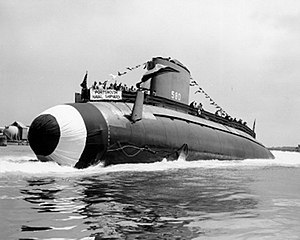USS Barbel (SS-580)

Launching of Barbel on 19 July 1958
|
|
| History | |
|---|---|
|
|
|
| Name: | USS Barbel |
| Ordered: | 24 August 1955 |
| Builder: | Portsmouth Naval Shipyard, Kittery, Maine |
| Laid down: | 18 May 1956 |
| Launched: | 19 July 1958 |
| Commissioned: | 17 January 1959 |
| Decommissioned: | 4 December 1989 |
| Struck: | 17 January 1990 |
| Fate: | Sunk as a target 30 January 2001 |
| General characteristics | |
| Class and type: | Barbel-class diesel-electric submarine |
| Displacement: | |
| Length: | 219 ft 6 in (66.90 m) overall |
| Beam: | 29 ft (8.8 m) |
| Draft: | 25 ft (7.6 m) max |
| Propulsion: |
|
| Speed: |
|
| Endurance: |
|
| Test depth: |
|
| Complement: | 10 officers, 69 men |
| Armament: | 6 × 21 in (533 mm) bow torpedo tubes, 18 torpedoes |
USS Barbel (SS-580) was the lead ship of her class of submarines in the United States Navy. She was the second Navy ship named for the barbel, a cyprinoid fish, commonly called a minnow or carp.
The contract to build Barbel was awarded to Portsmouth Naval Shipyard in Kittery, Maine on 24 August 1955 and her keel was laid down on 18 May 1956. She was launched on 19 July 1958 sponsored by Mrs. Bernard L. Austin, and commissioned on 17 January 1959, with Lieutenant Commander Ord Kimzey, Jr., in command.
Barbel-class submarines were originally designed and built with bow planes. On 30 November 1960, the Barbel had been operating off the coast of the Eastern U.S. while participating in training exercise SLAMEX. Following her first dive of the day to test depth (700 feet), she ruptured a 5" line used for cooling equipment which circulated sea water throughout the boat at sea pressure. An emergency blow was performed and on reaching the surface it was found that she had taken on 350 long tons (360 t) of water in the engine room. She entered Portsmouth Naval Shipyard and underwent major repairs of all her piping over 2". At that time, her bow planes were also converted to fairwater planes.
In 1966 Barbel accidentally rammed and sank North Vietnam's largest freighter while trying to determine what type of war-related cargo it was carrying. Although damaged, Barbel was able to remain submerged and return to port for repairs.
During the 1950s and 1960s, the early classes of nuclear submarines suffered propulsion plant reliability problems, and occasionally were unable to complete their assigned missions. In 1969, while deployed in WESPAC, Barbel was assigned to fill in on a "special mission" for such a nuclear submarine. It was noted by the control room watch standers at that time that there should be some sort of recognition badge, similar to the recently authorized "Polaris Patrol Pin", for diesel boats required to fill in for a broken down nuclear submarine. A contest was held to design the badge. ETR3(SS) Leon Figurido's winning design was a broadside view of a guppy submarine with SS superimposed on the North Atlantic sail. There were two bare-breasted mermaids facing towards the sail with arms outstretched. Completing the design was a wreath under the boat, with holes for stars, and centered on the wreath were the letters "DBF" standing for "Diesel Boats Forever". And so was born the DBF pin.
...
Wikipedia
